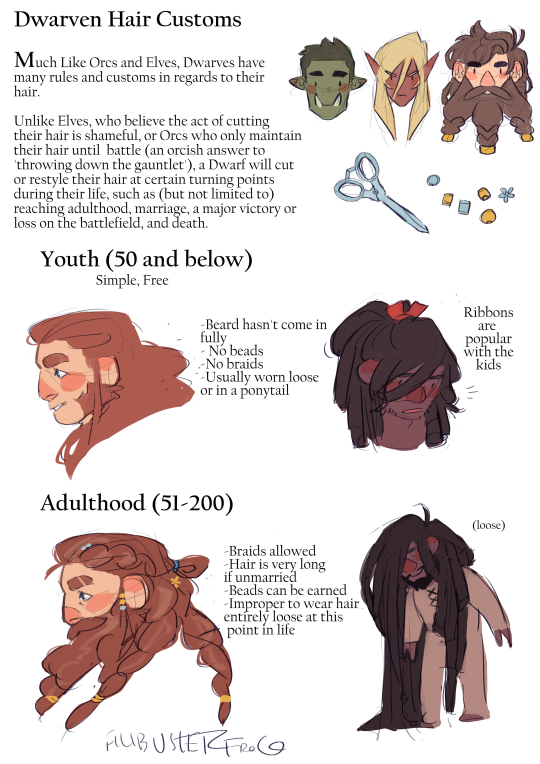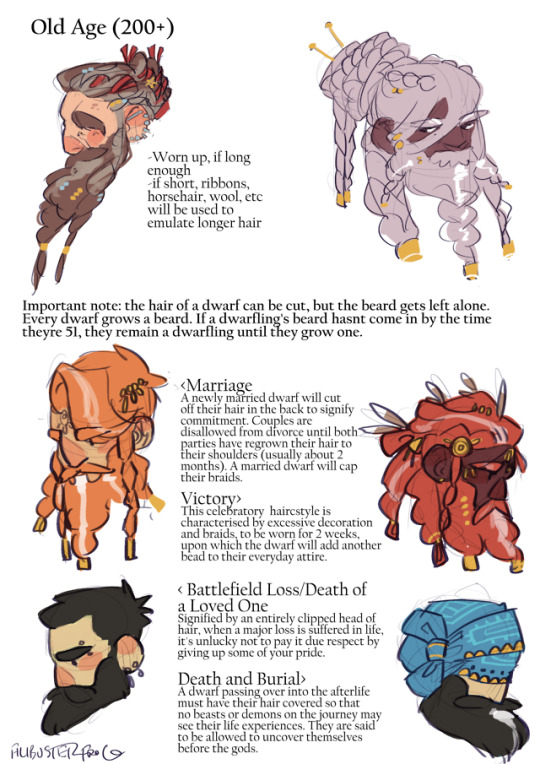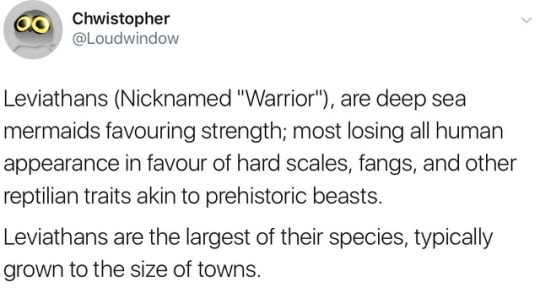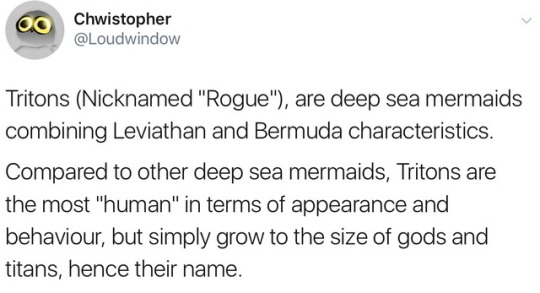Posts about RPG ideas that are maybe okay!| INBOX: OPEN My main is: static-sugar-pop and I follow from there!
Last active 3 hours ago
Don't wanna be here? Send us removal request.
Text
(With Kids on Bikes in mind)
A punk band that performs in cemeteries, purely for the vibes! Definitely not because the main singer is actually a necromancer about to raise an army of undead with the bands music.
#rpg idea#rpg ideas#kids on bikes#kids on brooms#necromancy#tabletop rpgs#tabletop#tabletop ideas#villain idea
18 notes
·
View notes
Text
Paladin oath #003
A wizard with a wand of true polymorph is recruiting adventurers by making them.
You used to be a warrior ant. You protected your heap and your queen. Now you have a human body and your former peers are insignificantly small compared to you. Still, you will protect them and your queen, you cling to that purpose. You join the wizard's task force since his enemy also threatens tho forest in which your colony lives.
143 notes
·
View notes
Text
It's very funny to me that the stereotypical gelatinous cube is bright fucking green when the monster itself is almost perfectly transparent. Like its gimmick is that it's a monster that imitates an empty 10x10 hallway. How many people have fallen victim to gelatinous cubes because they "know" that the ooze is bright green and so don't bother to check the suspiciously clean corridor in front of them.
49K notes
·
View notes
Text
i care so much about fictional morality and ethics but not in a lame ass "is this character/ship problematic" way. i'm cringe for other reasons.
54K notes
·
View notes
Note
So I've been looking for ideas on how to start a campaign. Help? Also, fellow DMs - how do you keep track of all the things during battle? Health and stats and such
The way that I start a campaign is I pick my big bad first! And build a world first.
My players keep track of their own health and stats. But for enemies I make cards with their stuff on them! There are also plenty of apps that will keep track of that stuff for you
33 notes
·
View notes
Text
Using children's mazes from coloring books is actually a really great tool for creating dungeon layouts!
#dnd#d&d#d&d 5e#d&d ideas#d&d stuff#dnd character#dnd quest idea#dnd quests#dnd ideas#dnd worldbuilding#d&d character#dungeons and dragons#dungeons and dragons ideas#dungeon master
152 notes
·
View notes
Text
You know what’s more fun than worldbuilding that makes some fantasy races EEEEVIIIIIIILLLLL!!!!? Worldbuilding that gives the different races cultural differences that help explain why there’s a lot of conflict between them:
Goblin culture doesn’t have a concept of “Property”. A stick on the ground and a tool in a locked shed are equally up for grabs if a thing needs doing. They casually take and leave things all over their communities, eat from communal pots, and genuinely Do Not Understand why the Core Races are so Angry and prone to Violence all the time.
Consequently Goblins who live near Core communities develop a reputation as “Thieves” despite not even having a *word* for that. (The closest word they have is more like “Greedy” and it means a person that hides things so nobody else can use them, and it’s a surefire fight-starter to call a Goblin that)
Common Orc Spiritual beliefs hold that a Soul can only grow stronger by overcoming Challenges in life, and see intruding on another person’s Challenge unasked for as not just Rude, but Deeply Harmful. You’re Stealing their chance to Grow. Asking for help is deeply personal and doing so can be both a way to grow closer with them or a too-personal intrusion, depending on your existing relationship with them. An exception is Children, as far as most Orcs are concerned, all Children are fundamentally the responsibility of the Whole Community, regardless of whose child they are, or even if said child is an Orc at *all*.
This means that Orcs who live near Core neighbors often seem Rude and Standoffish if not outright hostile, because they neither ask for nor offer aid even in times of trouble, and respond to unasked for aid themselves with Anger. There are even rumors that they Steal Children, because if an Orc finds a child lost in the woods they’re pretty much immediately going to start feeding it, and if they can’t find where to bring it back to, or it doesn’t seem to be well cared for, they’re just gonna keep it.
91K notes
·
View notes
Text
Ok so imagine your fantasy setting with your typical giant spiders.
Ok, now imagine that these spiders have largely been domesticated for their incredibly valuable silk. They help make clothes, rope, textiles, even ARMOR. They’re almost treated like carnivorous cows in the regions that can support them. They might even name these girls the classic names like “Bessie”. They’re great mothers and produce many young; useful for trade and… even food if you like The Crunch.
People in this world are hardly afraid of big spiders the same as we’re hardly afraid of big dogs. Wary of wild ones, but not scream and cry terrified. Smaller spiders…it depends. Would you be scared if you suddenly saw a tiny cow crawling on your wall? The only type of spider people collectively fear are the hunting types: the ones that don’t spin webs, and instead attack their prey with brute force and a much stronger venom.
These large domestic spiders are incredibly lazy. They’ll sit in their webs and wait for their handlers to put their food on the web. Unless you get tangled, they don’t see you as food. This makes them great guards as well. They build traps for you. The venom isn’t deadly to humans…but can still be used as a weapon or in medicine. They’re just so damn useful that millennia ago, people put aside their instinctual fear just to get those sweet benefits.
Thank you for attending my TedTalk.
29K notes
·
View notes
Photo
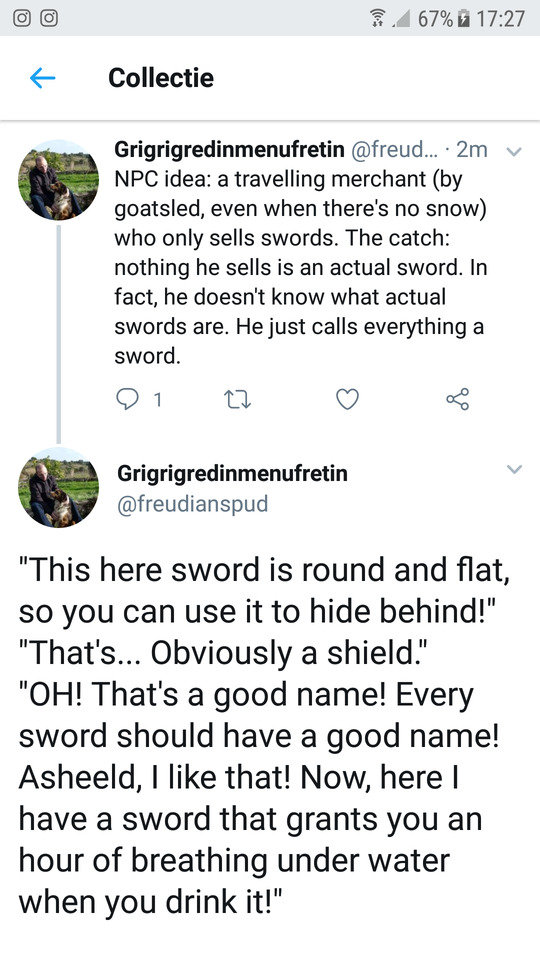
I had an idea for D&D
(Edit: Boy this post took off! A colleague of mine and I came up with the swordmerchant, and neither of us knew about the pants smith until another colleague pointed out the similarities. I have since checked out the Drawfee bad jrpg series and it’s brilliant!)
59K notes
·
View notes
Text
Building an Embodiment of the Fairytale Princess in Dnd 5e
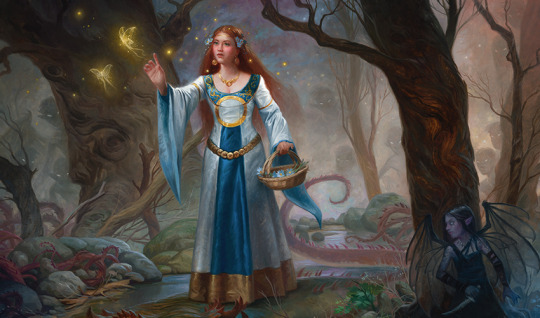
No matter who you are, when someone mentions fairytales, we all think of the stock characters. You’ve got your beloved princess, your charming prince, and your tempting witch, with maybe a malicious dragon thrown in for flavor. And that’s what we’re looking to build today. Not any specific princess, but rather an amalgomation of every fairytale princess and princess trope in one character.
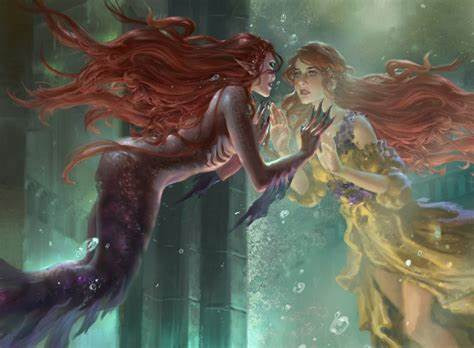
For race, we’ll go with a human, or to be more specific a variant human. We were blessed by fairies since birth, and they gave us the gift of magic. The fairies gave you magical beauty and grace for +1 CHA and +1 DEX, as well as the gift of song for Performance for your fey-blessed skill. Their good wholesome magic left some residue of goodness magic, so we’ll pick up Magic Initiate and choose the Cleric for some good, wholesome spells. We’ll pick up the Spare the Dying and Word of Radiance cantrips and the spell Guiding Bolt.
For alignment, we’re practically a saint, so we’re lawful good.
And for background we’re a pretty obvious Noble for Persuasion and History.
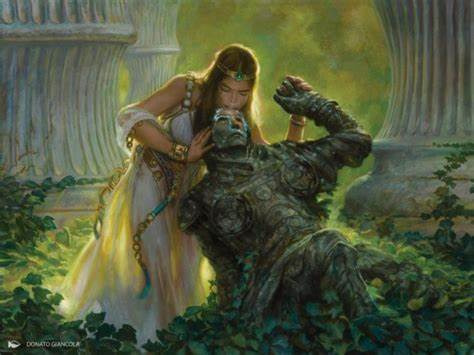
To be a classic fairytale princess, we’re going to need to be able to sing, summon critters to do our chores, and have a fairy godmother who watches over us. The best way to do all three is to be a Bard and an Archfey Warlock. However, in order to use the Bard to their full extent, the Bard has to reach level 18 to get all of their bardic secrets. Luckily, everything we need from the Warlock can be gotten in the first two levels. All we need from Warlock are the spells Eldritch Blast, Mage Hand, Armor of Agathys, Charm Person, and Unseen Servant. Then we get two eldritch invocations, we’ll pick up Beast Speech so we can talk to animals permanently and agonizing blast to make our eldritch blast a more effective cantrip.
For this build, Charisma is our top priority. We’ll want a good Constitution to maintain concentration spells, a good Dexterity since all we’re wearing is a set of clothes (fine), and a good Wisdom score primarily for the use of Animal Handling. Strength and Intelligence will get dumped. We’ll be sure to take up expertise with Animal Handling, Persuasion, Performance, and Religion, because you’re a good medieval girl who eats all her vegetables and goes to bed on time.
Fairytale-Based Spells
Basic Fairies
Dancing Lights: they’re called fairy lights for a reason. Faerie Fire: faerie lights that help you keep track of foes. Healing Spirit: a nature spirit with a fey appearance that heals your party. Spirit Guardians: They can take on a fey appearance, dealing radiant damage Conjure Woodland Beings: You summon fey creatures to help you fight. Conjure Fey: you summon a greater fey to help you fight
Snow White
Armor of Agathys: Surround yourself in a barrier of ice when injured. Reflavor as Snow White’s glass coffin.
Cinderella
True Polymorph: the fairygodmother turned mice into horses and a pumpkin into a carriage. Wish: everything the fairygodmother did was to make Cinderella’s wish come true.
Sleeping Beauty
Dawn: a loose connection, but one of sleeping beauty’s names is Aurora or Dawn. Dream: useful for when you’re asleep and need to call someone to save you. Wall of Thorns: to keep the princess safe, the fairies raised a ticket of thorns around the castle, which only parted for the handsome prince.
The Little Mermaid
Suggestion: Mermaids have hypnotic voices that lure men to their deaths. Tidal Wave: Mermaids control the tides and waves Mass Suggestion: How to brainwash an entire ship crew. Control Weather: Mermaids were blamed for violent sea storms. Tsunami: Like tidal wave, just bigger and more destructive.
Beauty and the Beast
Unseen Servant: In the original story, the beast’s servants were invisible. Tiny Servant: to bring a tiny object to life, like the Disney version. Animate Objects: make the room attack someone, like the Disney version. Charm Monster: beauty soothes the savage beast.
Rapunzel
Rope Trick: You create a safe pocket dimension that can only be reached by climbing. Galder’s Tower: create a two story tower. Reminiscent of Rapunzel’s Tower.
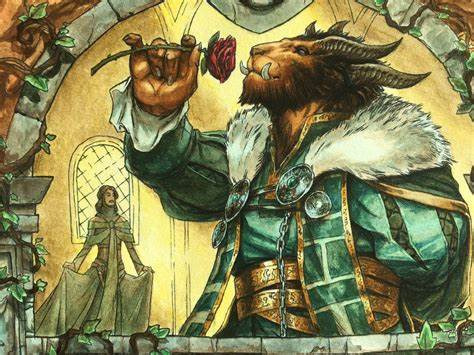
Race: Variant Human Background: Noble Alignment: Lawful Good Class: Glamour Bard (18) Archfey Warlock (2) Base Stats: Strength: 8 (-1) Dexterity: 14 (+2) Constitution: 16 (+3) Intelligence: 10 (0) Wisdom: 14 (+2) Charisma: 20 (+5) Saving Throws: Strength: -1 Dexterity: +8 Constitution: +3 Intelligence: 0 Wisdom: +2 Charisma: +11 Combat Stats: HP: 163 AC: 13 Speed: 30 Initiative: +2 Proficiency Bonus: +6 Passive Perception: 18 Dark Vision: 0 feet Proficiencies and Expertise: Animal Handling History Perception Performance Persuasion Religion Skills: Acrobatics: +5 Medicine: +5 Animal Handling: +14 Nature: +3 Arcana: +3 Perception: +8 Athletics: +2 Performance: +17 Deception: +8 Persuasion: +17 History: +6 Religion: +12 Insight: +5 Sleight of Hand: +5 Intimidation: +8 Stealth: +5 Investigation: +3 Survival: +5
Spell Slots
1st (6) 2nd (3) 3rd (3) 4th (3) 5th (3) 6th (1) 7th (1) 8th (1) 9th (1)
Fairytale Spellbook
Cantrips 3rd Level Dancing Lights Conjure Animals Eldritch Blast Mass Healing Word Friends Spirit Guardians Light Tiny Servant Mage Hand 4th Level Mending Charm Monster Spare the Dying Conjure Woodland Beings Word of Radiance 5th Level 1st Level Animate Objects Armor of Agathys Dream Charm Person 6th Level Command Mass Suggestion Faerie Fire Wall of Thorns Guiding Bolt 7th Level Healing Word Mord’s Magnificent Mansion Speak with Animals* 8th Level Unseen Servant Glibness 2nd Level 9th Level Animal Messenger True Polymorph Enlarge/Reduce Wish Enthrall Healing Spirit Suggestion
Actions:
Countercharm. Creatures within 30 feet get advantage against being charmed or frightened following a performance check.
Bonus Actions:
Bardic Inspiration. Add 1d12 to an ally’s d20 roll 5 times per long rest.
Features:
Eldritch Invocations. Agonizing Blast. Add your Charisma mod to your Eldritch Blast damage rolls. Beast Speech. Cast Speak with Animals without using a spell slot. Enthralling Performance. Up to 5 creatures must make a DC 19 WIS saving throw or become charmed by you. Fey Presence. Creatures within 10 feet make a DC 19 WIS saving throw or become charmed or frightened by you until the end of your next turn. Font of Inspiration. Regain all uses of Bardic Inspiration on a rest. Jack of All Trades. Add +3 to skill checks you’re not proficient in. Magic Initiate. Choose two cantrips and a 1st level spell from the cleric spell list. Mantle of Inspiration. As a bonus action, give up to 5 creatures within 60 feet 14 temp HP points, and they can move without provoking an opportunity attack. Position of Privilege. You are welcome in high society, common folk go out of their way to accommodate you, and you can get an audience with other nobles. Song of Rest. Regain 1d12 extra HP on a short rest after singing. Unbreakable Majesty. Take on a majestic appearance for 1 minute, the first creature to target you each turn must succeed on a DC 19 Charisma saving throw or choose another target. If it succeeds, it has disadvantage on saving throws against your spell DC next turn. Use once per long rest.
Fairytale-Based Items
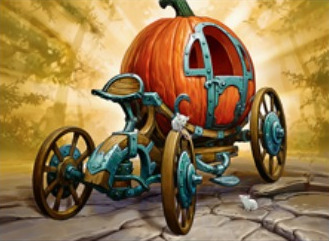
Pumpkin Carriage (Cinderella)
Common Wondrous Item - Vehicle
Weight: 600
This vehicle ignores difficult terrain.
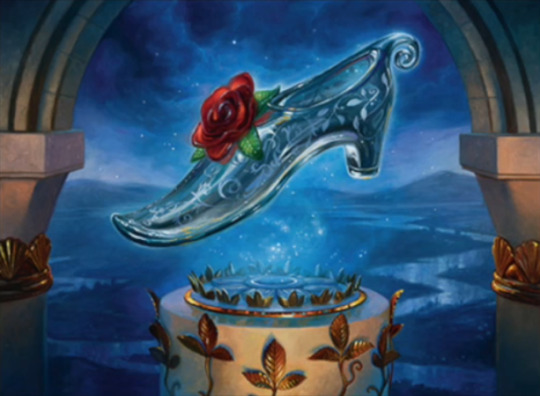
Glass Slippers (Cinderella)
Rare Wondrous Item - Attunement Required
Your movement speed isn’t slowed by difficult terrain, and spells and other magical effects can’t reduce your speed. However, you cannot cross terrain that would harm you, such as lava. Because the shoes fit only one person in the entire kingdom, this item requires attunement.
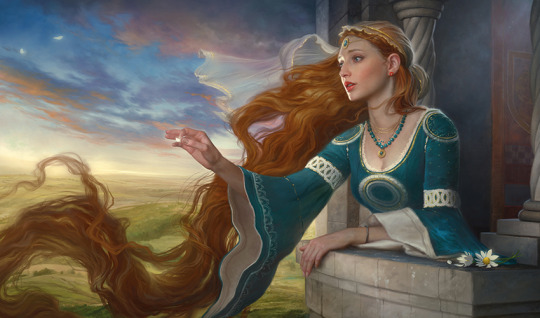
Golden Stair (Rapunzel)
Rare Wondrous Item - Attunement Required
Your long hair can be used as a Rope, Hempen and a Grappling Hook. It’s attached to your head, so it cannot be broken, stolen, lost, or used up. The hair can also be used like a lasso to bind and pull switches or objects weighing 10 lbs or less closer. It has a range of 60 feet. Because it is attached to your body, this item requires attunement.
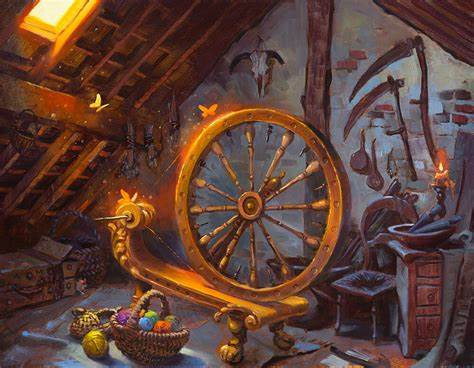
Sleeping Spindle (Sleeping Beauty)
Rare Weapon (Dagger)
This cursed spindle deals 1d4 piercing damage. When a creature is struck by this blade, they must succeed on a DC 15 Constitution saving throw or fall into a magical sleep for 24 hours. The curse can be broken by the spell Remove Curse. Once the curse has been used, it cannot be used again until the dawn of the next day.
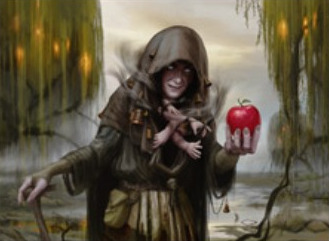
Poison Apple (Snow White)
Common Weapon (light, thrown)
When this item is thrown, deal 1d4 bludgeoning damage to any creature it hits. When this item hits a creature or a solid surface, it explodes, creating a poisonous cloud within 5 feet centered on where it landed. Creatures inside the area of the cloud take 1d4 poison damage and make a Constitution saving throw against DC 10 + your INT mod or become poisoned. Crafting: requires fresh fruit, a poisoner’s kit, and knowing at least one spell. Crafting takes 10 minutes.
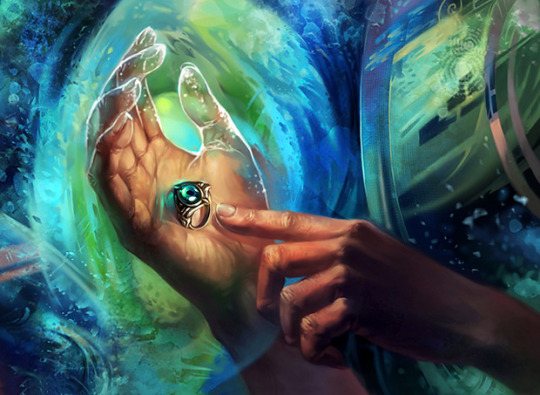
Ring of Teleportation (Beauty and the Beast)
Epic Ring - Attunement Required
Choose up to three locations you have been to before and know well. Once per day, turn the ring three times and you and any creature touching you will be teleported to whichever location you desired. You can change your three saved locations at any time, but you must be at the location to save it to the ring. The ring resets at dawn following its last use. Because the ring can only take you to places you’ve been before, the ring needs to be attuned to you.
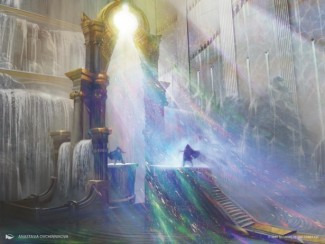
Magic Mirror (Beauty and the Beast/Snow White)
Legendary Wondrous Item
Once per day, choose one of the following:
Cast Scrying without using a spell slot. The mirror will show you what you ask to see.
Cast Legend Lore without using a spell slot. Ask the mirror a question and it will answer truthfully to the best of its ability.
5K notes
·
View notes
Text
Random mansion generator


The Procgen Mansion Generator produces large three-dee dwellings to toy with your imagination, offering various architectural styles and other options. Each mansion even comes with floorplans:
https://boingboing.net/2019/07/12/random-mansion-generator.html
241K notes
·
View notes
Text
D&D Worldbuilding: Cities
Planning
There are a few ways to plan out a city for your D&D campaign and they can be as detailed or as specific as you need. Figure out what you need the city for.
Main Hub: If the entire campaign revolves around this city, it’s important to flesh it out with detail so you can answer PCs’ inevitable questions and let them do what they want to do. Create complex relationships between NPCs, factions, economy, religion, and politics for the PCs to unravel each time they return to the city.
Major Location: This won’t be the only city the PCs visit, but they will spend some time here. Flesh out the city with its various districts and some relevant plot hooks and NPCs. Flesh out the city by working from vague to specific as players spend more time there. You don’t want to develop the place too much if the players end up leaving for another location.
Just a Visit: If the PCs are only visiting the area, you only need to plan or map out the relevant parts of the city and create the NPCs they need to encounter or are likely to encounter (like shopkeepers when they go to restock supplies). Plan out a description of the city with a few key landmarks and interesting features that give the city character if they wish to revisit it later.
Passing Remark: The players will likely never reach this city unless they work toward it. Come up with an elevator pitch with a one-sentence description of the city so the campaign world feels larger and maybe you will even entice them to go. What is the city famous for? What is its most prominent landmark? What are its relationships to other cities (trade/politics)? Once you answer these you don’t need to go any further until the PCs say “We want to go there”
Once you know how detailed you need to be, there are two ways to plan a city (two that I use, anyway). I will either create a list of traits to inform how the city looks, or create a map and use it to inform what’s in the city. Often, these methods end up playing with each other and lead to map reworks or second drafts, and that’s okay. Trust me, your first idea is never your best!
Map Draft
Let’s start with making a map because it’s more freeform and easier to explain. The first thing you decide when making a map is what the focus will be. This will often be a power center (like a castle or tower) or an identifying landmark (like a mountain, lake, great tree, giant shard of crystal, anything really). Once you have that, work fast and loose to imagine how the city springs up from there. Create masses of buildings (not individual ones) and create districts. Give the map an interesting and asymmetrical silhouette or shape (unless you’re going for a symmetrical look to emphasize a city’s lawful alignment). As you get more detailed remember that everything should highlight the focal point for your city map. As far as specific areas to fill in, here is a handy list of things to keep in mind.
City Defenses: In a world with giant creatures and cloistered kingdoms, some cities opt for walls, gates, towers, siege weapons, or other such things.
Commerce Center: Where does the majority of trade take place in the city? Are there different areas for this?
Districts: Most cities tend to divide into districts, like residential, commercial, industrial, governmental, religious, or military districts. Try to come up with unique districts that let them differ from districts in other cities.
Entry Points: Where do people enter and leave the city? There is most likely more than one way to do so (for the safety of the city).
Landmarks: Besides the focal point, your city should 100% always have something the players will remember to help them visualize the city. There can be other smaller landmarks, perhaps one in each city district.
Lower Class: If you have a lower class district, they will have smaller, more densely-packed buildings. They may exist both inside and outside the city walls, but tends to spread further from the power center.
Power Center: Whoever leads the city is probably going to have a big building or walled district or point of interest to display their station.
Upper Class: If you have an upper class district, they will have larger buildings, more leisure space, more monuments, and possibly be walled off from the rest of the city. They are more likely to be closer to the power center.
Water source: Many cities needs access to water to keep their huge population alive, so don’t neglect this.
City Features/Traits
Cities have a variety of traits that make them unique from one another. Determine the nature of these traits to help flesh out your city. A flavorful city has positive traits and negative ones; strengths as well as flaws.
Power Center/Government: Who holds the power in your city? Look at various forms of government and don’t limit yourself to just monarchy. Cities can have a democracy, republic, military, theocracy, or perhaps an arcane form of leadership. You can get creative with fantasy elements or add complications to your government to make the city unique: perhaps a strange sentient crown controls the queen, or a ghost of a king maintains control of their monarchy beyond death. Perhaps the oligarchy is a sham and a secretive cult really bends the city to its whims.
Complications don’t always means evil plots, but they can make things difficult when trying to influence the city as a whole. The city’s government isn’t necessarily its center of power. If the city’s senate is in the thieves’ guild’s pocket, the PCs may have to parley with the guild instead of the senate.
Economy: Cities aren’t often self-sufficient. They specialize in certain resources and lack in others, which leads to imports and exports. A mining city might have a booming metals and stone industry, exporting raw ores and gems or even refined ones with jewelry, but might lack in wood or food and need to import it from a neighboring town. These help define the city’s relations to other cities nearby. The city’s economy can also differ within its own gates. Consider the disparity of wealth in your city between the rich and poor.
How does the city spend its wealth? An interesting city will prioritize one aspect over others, or neglect one aspect in favor of others. Here are some things a city can spend its wealth on:
Expansion: The city seeks physical growth by buildings structures to expand its borders or establishing colonies in distant lands. Cities that neglect expansion might not suffer as much but may be content with their position on a global scale.
Infrastructure/Transportation: The city focuses on being as efficient as possible with well-maintained systems and structures in place. A city that neglects infrastructure might find themselves at odds with merchants and nobles who frequent the use of roads and bureaucratic systems, while residents are forced to tolerate the city’s difficulties.
Residences: The city focuses on making its housing maintained and affordable and expanding. The city wants people living inside it rather than commuting to the city. A city that neglects this may have slums or shantytowns and may be over- or underpopulated.
Military/City Defense: The city seeks to defend itself by maintaining its walls and guard towers, ensuring regular and frequent patrols and lookouts. They likely have a standing army that is maintained in case of attack. Perhaps their relationships with other kingdoms are strained. A city that neglects this is either in peacetime or is vulnerable. The streets may be rampant with unchecked crime.
Education/Technology: The city seeks to improve its people and its efficiency. In the case of a fantasy city, this may involve magic and magic items, but could also simply be a city attempting to revolutionize and move beyond other cities with something that improves an existing system. A city that neglects this may have masses that are easier to manipulate and may be stuck in the past.
Food/Health: The city focuses on its people’s wellbeing by ensuring they can get enough food and water to live and enough health care (either through doctors or priests) to persist. A city that neglects this may have very unhappy and unhealthy people. The masses tend to revolt when their society betrays them of these core things.
Extravagance: The city focuses on its appearance or the arts. The city may have a lot of excess wealth to spend on this or might rely on pilgrims and tourists for its economy and presents a gorgeous face to draw them in. Cities often neglect this first unless they are doing well or the rich seek to pacify the poor without giving up their station. Cities that do neglect this are often utilitarian with only a few striking monuments or important structures.
Military: What serves as the city’s military? Try to pick a focus for the city that takes advantage of its position. A coastal city will have a powerful navy to defend its docks and trade routes. A mountainous city may have fantastic archers and catapults to take advantage of their height. A city surrounded by plains will have a good cavalry to make quick maneuvers. A city in a wooded region will have infantry to navigate the terrain better than cavalry, and take advantage of the plentiful cover against arrowfire.
How large is the military? One city might have a daunting and powerful military presence while another might only have a standing militia. It depends on how much conflict the city faces, within and without its walls.
How does the city use its military? Are they actively defending the city? Are they campaigning in foreign lands? Are they attacking another city? Is the military used to keep its rebelling population in line? Consider this, as it will prominently let players know what the city and its leadership will live and die for.
Religion(s): Cities might have multiple religions or just one. Choose which ones feature prominently in the city, if any, and how much city life revolves around those religions. I won’t go into the detail of every deity and religion in the D&D universe, but consider that each has its own specific dogma, style, and portfolio that will influence how its worshipers act. A city that worships a chaotic-evil deity will differ vastly from one that worships a lawful-good one. A city with many deities will be different than both.
Figure out where each religion’s center of power lies in your city, and how much influence they have.
Shops/Taverns: Although they often serve as minor details in the grand scheme of a city, shops and taverns should be interesting and memorable for the players’ experience. Shop owners and innkeepers are an important reflection of the city, demonstrating how the populace views the city in which it lives. Moreover, filling a shop with items to buy and a tavern with quest hooks gives the players easy places to restock and find information when visiting the city. Put interesting characters in there to help characterize the city.
Landmarks: Landmarks define the setting and location and can even serve metaphorical or narrative meaning for the city. They help players visualize the city in their mind and remember it. Landmarks can be manmade or naturally-occurring, as long as it gives players groundwork to know where they are. The bigger and more unusual it is, the more interesting and memorable your city will be. Is there a giant shard of permanently-frozen ice from an ancient white dragon’s attack eons-ago looming as a grim reminder over the city? People tend to remember that sort of thing. Every city should be interesting, but just keep in mind not every city needs to have the same level of intrigue. If you have a main city the plot centers around, then go ham and go weird.
City Story: Cities can have stories just like any character, and when you start treating them like a character, it can have amazing results. Cities have backstories, conflicts, allies, and are filled with unique individuals who all contribute to the city’s traits.
History of the City: Cities aren’t built in a day. What happened to the city in the past to bring it where it is today? Disasters and war are useful historical tools that can be built around. The city recovers from such things but might never be the same. I have a city where a dragon’s attack caused a landslide that revealed an entry to the Underdark, and an entire city district built itself around it years later. History also adds layers to your campaign setting and makes it feel bigger and more unfathomable.
Factions: Cities draw people together, and people tend to group into communities. Those communities often have different goals that can come at odds with one another. This is where factions come in. Decide which factions are the most prominent in your city, establish their goals and ideals, and perhaps find a way to identify them. Figure out how they relate with other factions and what actions they have taken or plan to take to achieve their goals. Players love joining factions and it can give them an important stepping stone into the story of your world. Factions can include guilds, religious organizations, noble families, consortiums, or many such things.
Districts: Separating the city into more digestible portions can help players get to know it better and diversify it by forcing you to come up with unique areas of the city. Of course, don’t limit your city to such divisions. A commercial district can have a residential building, and an upper-class area can have an abandoned building housing squatters. The districts can even just be divisions in name only, much like street names. They may even be more memorable if they bear a unique name rather than simply “Merchant Ward” or “Warehouse District.”
What’s more interesting is creating something visually or culturally different for each district. Perhaps a district of a city named Towerhamme was built by giants from ages past and the colossal buildings have been subdivided by the humans now living there. Another district might consist of predominantly Thri-Kreen who worship Bralm (the goddess of insects and industry) and all speak a different dialect that mixes Thri-Kreen and Common. A district might lie in the dark underneath another district, with pillars as thick as trees holding up the buildings and streets above it, and come to be called the Night-Stone Forest. Not every district needs to be a didactic description of what’s in it.
NPCs: You don’t need to list everyone in the city, but make sure you know who the important people are. Name the people who are in power; those leading the government, religions, and factions. Name those important to your storyline. Think up interesting NPCs for the taverns and shops in your city. And most importantly, keep a list of random names handy so you can come up with them on the spot when PCs talk to people you didn’t prepare for. It may even be helpful to come up with interesting characters complete with backstories that the PCs can meet as allies or enemies. Just be careful with this, because you don’t know which NPCs your characters will become invested in until they do. The random throwaway character might be their favorite person to talk to while the most unique character that you delved into the deep history of was too boring for them. Make characters like crazy, but make backstories when you have to.
Foreign Relations: In terms of a city as a character, these are your city’s “bonds.” How does the city deal with other places? Economics and trading can be a large influence on how a city feels about another city or territory. If they rely a lot on each other they will tend to help each other out. If not, they might be indifferent or even enemies. Members of cities might feel differently than the city as a whole, but the city’s leadership most definitely will take some sort of diplomatic stance against other cities or territories.
A city’s diplomacy can be important to a storyline and add to the tone for the campaign. If two cities dislike each other, players will feel the tension if they travel between them. Friendly cities will be a different experience that carries less tension and more of an exploratory tone as the PCs wonder what awaits them.
City relations can also create opportunities for players to get involved, letting them ignite wars or resolve them can be important if that’s what the PCs want from the campaign.
4K notes
·
View notes
Text
An rpg that starts off in new game+ but the party has no memories of their original adventure but everyone else does.
47K notes
·
View notes
Text
Side quest idea: a village has been impacted by a mysterious plague that the clerics cannot seem to heal. Everyone seems deathly ill with no known cause.
Reality: everyone in the village is a hypochondriac and it all started with person faking sick to get out of work and it escalated from there.
#submission#dnd#dnd tag#dnd shenanigans#dnd ideas#dnd quest idea#dnd quests#d&d story#d&d campaign#d&d#d&d 5e#d&d homebrew#d&d ideas#d&d 5th edition
370 notes
·
View notes
Text
Worldbuilding: Religions

Religions have many different aspects that should at least be given thought if not careful consideration. Use these to guide your creative process when developing new religions and deities.
Key Aspects
Deity/Pantheon: Your religion does not need to necessarily have a deity, and it can even have an entire pantheon. I would venture that while a trained priest might perhaps specialize in one deity, a religion can have many.
Dogma: What are the principles and teachings of your religion? What does the deity implore of their worshippers? What is and isn’t allowed? What are the ethics of the religion? Why must we follow these principles?
Symbols: As important as the religion’s dogma are its symbols. How is your religion recognized on flags, tabards, armor, weapons, artwork, and holy symbols? Does your religion have a holy color or color scheme that they could use for their priestly robes?
Temples: Where are the religion’s places of worship? They could be secluded and secret or in/near cities. What do they look like? Are they merely household shrines or grand cathedrals? Do they have any distinguishing features?
Religious Practices
Rites and Rituals: What sorts of special ceremonies do the clerics of your religion practice? Are there any special material components that have meaning for the religion, deity, and ceremony? How long do ceremonies take and what is supposed to come from them? Rituals always serve a purpose, even if that purpose is merely affirming your faith. Rituals are useful as story elements as well as for players to perform.
Affirming Faith: telling your god you’re there and in prayer. It can be as simple as a daily prayer or weekly ceremony or more in-depth like a monthly or yearly ritual.
Proving Devotion: proving your faith to your god, usually meant for those who might be in doubt or who have wavered.
Initiation: rituals for new members to the religion.
Induction: rituals for new clergy members or clergy moving up in hierarchy.
Satiation: your deity demands sacrifice of something valuable to you or to it.
Boon/Blessing: the ritual seeks something of your deity, perhaps a bountiful harvest or victory in battle.
Magic: a ritual might be held to cast certain spells or perhaps to increase the power or scope of a spell. These can also be used in creation of magic items.
Healing: rituals for performing healing magic.
Funerals: ceremonies for the dead.
Marriage: ceremonies for binding individuals together spiritually
Holy Days: Often rituals can coincide with special days or times of the year. Holy days can be predicted and often signify important seasonal or historic events. Harvest, springtime, solstice, and equinox holy days are common, as are those commemorating the deaths of martyrs or important dates in the religion’s history.
Myths/Legends: Are there any stories or parables that your religion teaches? What stories of the gods do they tell? Do they have any specific myths relating to things like the creation of the world, the creation of elements, the invention of everyday things, or perhaps the invention of morality?
Prayers/Sayings: To help you roleplay priests of this religion, you can come up with some common greetings, farewells, and blessings that might be associated with the religion. “Pelor shines upon you” and whatnot.
People
Titles/Hierarchy: What are the ranks of the clergy and do they have any special titles? Are there any notable NPCs in the religion’s hierarchy? For instance, those that worship Mammon, the archdevil of greed are often called Covetors.
Clergy: Do the clergy perform any services for the rest of the population? Usually this involves healing or holding ceremonies, but they could have a broader scope in a theocracy or a narrower scope if secluded or unpopular. What do the clergy look like and wear? Do they favor certain classes other than clerics?
Worshippers: What sort of people are drawn to the religion? Are there certain races, classes, or kingdoms that worship them? What convinces them to follow the religion’s dogma? Is it out of fear, necessity, protection, comfort, or prosperity?
Relations: Does this religion have allies or enemies? These could either be allied or rival churches, deities, or religions. Furthermore, certain kingdoms or people could ally with or oppose the religion. Think of how each faction and religion in your world sees this religion.
Culture
Art: How does your religion express itself? Define your religion’s art, architecture, fashion, and songs and how they compare to other religions and cultures.
Relics: What sorts of holy relics belong to your religion? These can be body parts or objects belonging to important martyrs or high priests or heroes that champion the religion. These might be kept in temples or may have been lost to time. Perhaps some are magic items being used by chosen (or unscrupulous) adventurers.
11K notes
·
View notes
